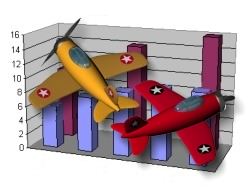| The Effects of 3d Vaporware
by John Reynolds |
||||
|
Why he chose to do so is not within the scope of this editorial, and the misinformation has nothing to do with the TnT2's performance or potential. To criticize non-final silicon running on immature drivers is just as wrong as lauding it. Instead, I wish to deal with Tom's erroneous methodology. Benchmarks produce numbers, quantifiers by which we may compare the quality of one product to that of another. And there are numerous benchmarks used for testing the internals of modern PCs, from sound cards to processors, hard drives to video cards. Unfortunately, not all benchmarks are appropriate to function as an independent gauge by which to obtain final, subjective conclusions. Case in point is Tom's use of only two benchmarks, the Crusher from Quake 2 and Tomsdemo from Shogo, (yes, you read that correctly, one of the benchmarks is a proprietary, in-house benchmark.) Both of these are highly CPU-limited by their nature. The Crusher benchmark, created by Brett Jacobs, is a running demo of an extremely intense Quake 2 death match session intended by its author to be indicative of a worse-case scenario of online play. Unfortunately, it's little more than a CPU benchmark, and has been dismissed as such months and months ago by most of the gaming community. Why? Because it doesn't serve its purpose, which is to test a system's video performance. Running Crusher at various resolutions on the same system produces performance variations of maybe 2-5 fps, even though going from 640x480 to 1024x768 is increasing the pixel density by a factor of 2.6. This clearly demonstrates that the Crusher demo absolutely does not stress the rendering abilities, largely determined by fill rate, of your current video setup. Framerate variations, however, do prove that the Crusher demo, particularly with higher-end machines, is not 100% CPU-limited, so it's most likely testing the setup engine, largely determined by driver quality, of the video board. Setup performance is certainly important, and as such reflects the board's level of dependency on the CPU, but cannot be used to the exclusion of other factors that impact performance. For maintaining consistent framerates during gameplay, especially with multitextured titles, nothing is more critical than fill rate, and neither of Tom's benchmarks truly tested the TnT2's fill rate performance. I consider this to be a glaring, perhaps intentional, omission. |

So therein lies the rub. By using a benchmark that stresses the CPU more than the video board, Tom was able to confidently announce that a pre-production video card, one with still largely unannounced final specs running on alpha drivers, will be the undisputed ruler of 3D acceleration. It's like declaring a painting complete with only one stroke of the wrong brush! The real danger is one of painting yourself into a corner. Ahh, the joys of vaporware. Let me mention again, for the record, that this editorial is not intended to slight the object of Tom's testing, nVidia's TnT2, but rather his testing methods. There have been other previews by more thorough individuals (such as Lloyd Case) using more appropriate benchmarks who have demonstrated that nVidia's latest offering appears to have enormous, if not 3dfx-shattering, potential. And these previews have managed to restrain from grandiose proclamations. Nevertheless, do yourself a favor and ignore the polls, because they're being fueled by vaporware, and simply wait for final product to ship before pulling a T. . .well, you know .. reaching for premature conclusions. But if you feel otherwise, give me a holler- there's a nice little upscale condominium right across the Brandywine River, outside the Shire, I'd like to sell you. |
|||
|
Copyright © 1997 - 2000 COMBATSIM.COM, INC. All Rights Reserved.
Last Updated March 29th, 1999 |
||||


